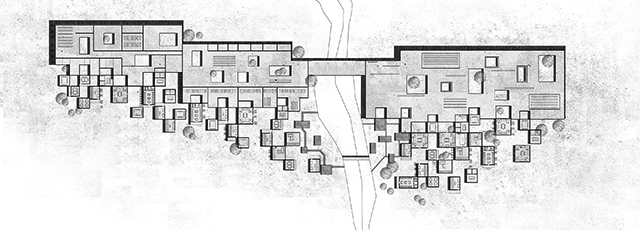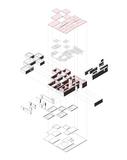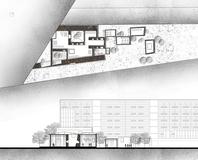
Rules, Adaptation and Inspiration
Yawen Hui; advised by Jonathan Bachrach, Sara Dean, Etienne Turpin, and Kyle Steinfeld

In this project, the systems inherent in a rule-based design take the position of a prompt, an artifice to activate the imagination of a human designer.
In creative work, rules and inspiration are often thought of as opposites. Rules bring to mind the objectivity of systems and the uniformity of a constrained set of results, while inspiration suggests the non-conformity and subjectivity of an independent mind. Beyond this superficial understanding, there lies a more in-depth link among systems, rules, adaptation and inspiration. In-situ rule-making may be regarded as a creative act, an encapsulation of a spontaneous inspiration that originates in, as Donald Schon would describe it, the "materials of a situation". Rules formed as such take on new significance in the context of a situated design problem - more than predetermined constraints, rules may serve as a device to activate further inspiration. To form new and better rules.
798 art zone is a district gathered galleries, art studios, cultural companies, fashion shops in Beijing. Attracted by ordered designing, convenient traffic, unique style of Bauhaus architecture, many art organizations and artists came to rent the vacant plants and transformed them. 798 art zone plays a role of beacon, give me inspiration to design an "art community" in Oakland. This place can attract many kinds of artists. They have their own studios and galleries. Some of them maybe interested in doing paper-cutting, oil painting, ceramic design, wood carving etc. The "art community" also has an "open day" that give visitors an approach to enjoy the arts.
Taiji pattern divides the world into yin and yang, similar to the positive part and negative part. Just like the map we draw from data, it divides the property of all buildings into public and private. Those two parts penetrate into each other.In this project the Taiji pattern is worked as a director to help me came up with the idea of inter-penetration between interior space and exterior space.
The spectrum combines with different color, and there is no specific boundary in it. In the mapping project, spectrum acts as the witness to tell us there is no clear boundary can divide the building into totally public and private. we need to give the difination and restrictions. And in the working environment context, spectrum works as the multi-function property, which combine the studio space with teaching space and exhibition space.
Dougong contains different parts. Such as dou, ang, qiao, sheng, gong, zuodou. All of them combine together to form the foundation of architecture. In the mapping project, Dougong works as an instructor to tell us gather data from different ways. All of them combine together to affect the mapping results. In the "art community" project, Dougong also acts as a system to set up connection among different units with variety functions.
Trees form a ring every year. The ring can record the age of the tree, and also can record some natural events, such as forest fires, landslides. Moreover, the formation of tree ring is a dynamic process. As long as the trees living, the ring will continuously spread. It provides me a new lens for understanding the site as well as architecture. They are full of vitality that contain lots of useful information about local conditions and will keep enriching themselves.












There's more!
Some other projects from this same class have been posted, as well as some interesting student work from this same year.